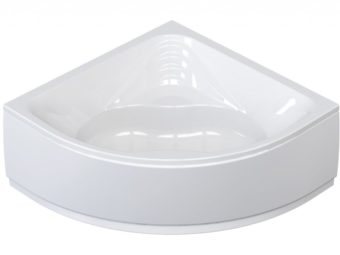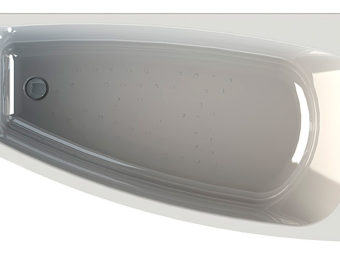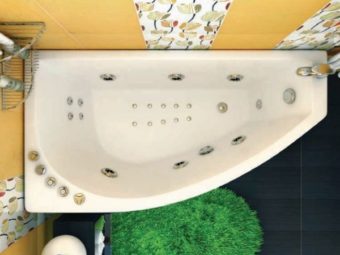Corner bathroom size. Corner bath: metal, ceramic and other options, sizes
In today's market, acrylic bathtubs are becoming increasingly popular. Dimensions, a wide choice of shapes, excellent performance properties make acrylic plumbing fixtures increasingly popular. Very often when carrying out repair work In the bathroom, the inexperienced consumer is faced with the dilemma of which bathtub will best suit the style of the room and will serve faithfully for a long time. First you need to understand the variety of existing structures. All of them are different in size, shape, material and additional functionality.
Bath shapes and sizes
Present on the market various designs: ellipsoidal, round, pentagonal/hexagonal, octagonal, etc. The classic dimensions of a regular bath are:
- length - 140, 150, 160 and 180 cm;
- in latitude - 70, 80 and 85 cm;
- height - 65 cm.
Additional functionality for bathtubs is represented by a variety of lighting, ozonating, massage and audio systems, armrests, headrests, etc.
It is worthwhile to dwell in more detail on the materials from which bathtubs are made. All the advantages and disadvantages of this design depend on them.
- Bathtubs made of cast iron.
Pros: good quality and durability, high level heat saving.
Cons: price; massiveness and heaviness (120, 140, 150 and even 160 kg); uniformity of forms; Rust and dirt get into the pores on the surface of the enamel.
- Baths made of steel.
Pros: lightness, variety of shapes and sizes, affordable cost.
Cons: does not hold heat well; makes noise when drawing water; fixation required.
- Products made of acrylic, quarry.
Pros: there are bathtubs of any shape, sizes 140x90, 160x70, 120 by 180, lightness (15-25 kg); smooth, pore-free surface, holds temperature well, does not make noise, and during repairs easily restores its original appearance.
Cons: Doesn't hold up very well high temperatures, gives a reaction to solvents and long-term contact with household chemicals.
There are also faience baths, wooden baths, glass (made of impact-resistant glass), marble and stone baths. As a rule, these options are purchased to maintain the stylistic unity of the room and do not have qualities.

In this review we will talk in more detail about acrylic bathtubs. They are made from a polymer substance (plastic). The main advantage of such a bathtub, as noted above, is the wealth of configurations and sizes. Their sizes vary in wide range, so choosing an acrylic bathtub for a room of any size will not be special labor, be it spacious baths 180 by 120 cm, 160 by 150 or compact options 120 by 90 cm or 160x70.
Acrylic bathtubs: varieties
Acrylic bathtubs are presented in a wide range color scheme, differ in a variety of configurations and dimensions. Many models are equipped with additional accessories, such as hydromassage structures and anti-slip corrugated surfaces. Acrylic liners are in great demand, which make it possible to restore a cast-iron bathtub using a modern acrylic “bath-in-bath” design.
The method is divided into:
- for bathtubs made of 100% acrylic,
- on a composite polymer structure,
- for bathtubs made of extruded acrylic.
The best operational properties It is 100% acrylic. Such products are less susceptible to deformation and more resistant to technical erosion. Combined and extruded polymers cannot boast of good waterproofing qualities. However, these options are quite popular. Manufacturers love them for their greater flexibility and ductility, and buyers love them for their lower cost.
Due to the fact that acrylic bathtubs are becoming more and more popular and in demand Russian market, I would like to dwell once again, but in more detail on their main advantages.
The main advantages of acrylic bathtubs
- The acrylic bathtub heats up quite quickly. Thanks to this characteristic, you will not experience discomfort from unpleasant emotions that arise when your body comes into contact with ice walls, as is the case with a cast-iron bathtub.
- “Silent” acrylic does not make any unpleasant rattling noise when filled with water.
- The bottom of acrylic bathtubs does not slip.
- Acrylic is an impact-resistant polymer, it is resistant to chips, and minor damage can be easily sanded out with a thin sanding sheet.
- Most acrylic structures weigh no more than 40 kg even with dimensions of 180 by 150, and standard baths 140x90, 160x70 weigh 15-25 kg, which is undoubted dignity during transportation and installation.
- Acrylic products are distinguished by a wide choice of shapes: circle, oval, rectangle, corner, semicircle, etc. In addition, the designs of acrylic bathtubs make it easy to equip them with a variety of accessories: seats, armrests, hydromassage, electronics.
- A variety of colors and many stylistic solutions for acrylic bathtubs make it easy to fit them into almost any interior. The colors are stable, do not fade or wear out over time, because the coloring of the product occurs throughout the entire mass, and not just on the surface.
- The acrylic bathtub is very hygienic. The smooth surface prevents the spread of bacteria.
Acrylic bathtubs sizes
Just a few years ago in stores in our country you could only find steel and cast iron baths of strictly regulated sizes, domestic bathtubs were produced in strictly defined sizes: 150 by 70 cm, 170 by 70 cm, 180 by 90 cm. With the advent of plastic acrylic, the range of bathtubs on the market expanded significantly. There is now an opportunity to purchase a bathtub to match almost any interior - unusual shape and non-standard size.
Compact models 120 by 70 cm and acrylic bathtub 150 cm long, and bathtubs resembling miniature swimming pools, the dimensions of which reach 180 by 120 cm or more. Corner acrylic bathtubs can also be purchased in a wide variety of options: 140 by 90, 140 by 140, 160 by 120, etc.
What sizes of acrylic bathtubs are optimal?
It is impossible to answer this question unambiguously. A design measuring 140x90 cm will fit perfectly into an ordinary bath; for non-standard rooms, it will be necessary to choose a bathroom with dimensions of 160x70.
Basic dimensional requirements when installing acrylic bathtubs
- The size of the bathtub should facilitate the smooth installation of the structure in the room. For example, an acrylic bathtub 140 by 70 or 150 by 70 is perfect for installation in a miniature bathroom, but a bathtub 180 cm long and 120 cm wide will require a larger room. At the same time, in rectangular rooms The same bathtubs look great, the dimensions of which allow them to be installed along the wall; in a square bathroom it would be more appropriate to install corner option with unobstructed access around the entire perimeter.
- Perhaps the main requirement when choosing a bath should be the constitutional characteristics of the family members for whom the bath is being selected. Hygienic procedures should provide convenience and comfort; the most optimal body position when taking a shower is reclining, this way maximum muscle relaxation occurs and you can count on a healing effect. The most popular models are those with dimensions of 140, 150, 180 cm in length; 90,100, 120 cm in width.

Acrylic bathtub: how to choose the best size?
- A height of 65-70 cm is the most optimal; it is easy to climb into such a structure.
- A depth of 50 cm is most preferable; in this case, it is easy for an adult to keep his head above the water; of course, it is not recommended to leave children in the bathroom unattended.
- Length - 140, 150, 160, 180 cm. This is an individual choice, depending on height.
- Width - 70, 90, 120, 140, 150 cm. Bathing procedures should bring comfort and pleasure, the design should not restrict movement, but at the same time fit organically into the space of the bathroom.
Based on your preferences, you need to select the sizes of acrylic bathtubs. There are many options for such designs on the modern market. And a visually inappropriate design can fit perfectly into the stylistic unity. It is a mistaken belief that standard sizes (for example, 160 cm) mean a standard design. If the layout of the room allows, the standard rectangle 160x70 may well be replaced by non-standard solution 160 by 160 cm. Moreover, if 160x70 is a typical solution for our apartments, then designs 160 by 160 allow us to accept water treatments two or three. So don't jump to conclusions. The choice of acrylic bathtubs is so wide that a simple design of 160x70, thanks to its unusual design, can become a real highlight of your bathroom. The main thing is that the shape of the bathtub best suits your preferences, and there will be no problems with the size of acrylic bathtubs.
How to buy a good and high-quality acrylic product?
A bathtub is a design with enough long term beneficial use. When purchasing an acrylic bathtub, it is worth carrying out a proper inspection. Useful tips The tips listed below will help you avoid buying an expensive but low-quality product.
- In the store, be sure to check the thickness of the acrylic layer. This can be done using an ordinary flashlight. To do this, you need to illuminate the wall on one side. If the reflection from the flashlight is visible on the other side of the product, then the walls of such a bathroom are too thin, it’s worth taking a closer look at another option. Quality baths are made from fabrics no thinner than 5 mm.
- It is worth studying the layers of reinforcement. The more there are, the better. It is necessary to carefully examine the edges of the walls; you will be able to see layers that resemble rings on a log frame of a tree. It is worth comparing their numbers in different models.
- It is necessary to tap the body. A booming sound indicates the quality of the specimen.
- An unpleasant chemical smell indicates the use of low-quality and cheap material. You shouldn't buy this model.
- When you run your hand over the surface, there should be no scratches, dents or other defects.
- The color of the bathroom should be even. Visible stains indicate marriage.

Bathtubs made of acrylic are quite resistant to damage, but it still helps to take precautions. Scratched and burnt areas can be cleaned with a fine-grained sandpaper; the original shine can be restored with polish. To clean the bathroom, it is preferable to use gel-based cleaning products and napkins made of natural materials. Difficult stains can be removed using a cleaning product. smooth surfaces. The scale is cleaned with a cloth soaked in lemon juice or vinegar. Caring for an acrylic bathtub is not particularly difficult. Regularity and accuracy will help your bathroom serve you faithfully for many years.
Corner mini-bath is perfect solution for a small bathroom where every centimeter counts. Standard plumbing cannot always fit comfortably into such a room, and a shower corner cannot fully replace a bathtub. Despite its compact size, a small corner bathtub is quite convenient to use; the main thing is to choose the right model.
Which baths are small?
The dimensions of corner baths depend on the shape of the model: for symmetrical standard parameters are 140x140 and 150x150 cm, for asymmetrical - 75x150 and 80x170 cm. All bathtubs whose dimensions are smaller than those indicated are considered small. At the same time, the width of asymmetrical models cannot be less than 70 cm, otherwise they will be inconvenient to use. The most popular among small corner baths are products measuring 120x120 and 130x130 cm, with a capacity of 200 to 300 liters. This category also includes small sitz baths, the dimensions of which are only 70x100 cm.
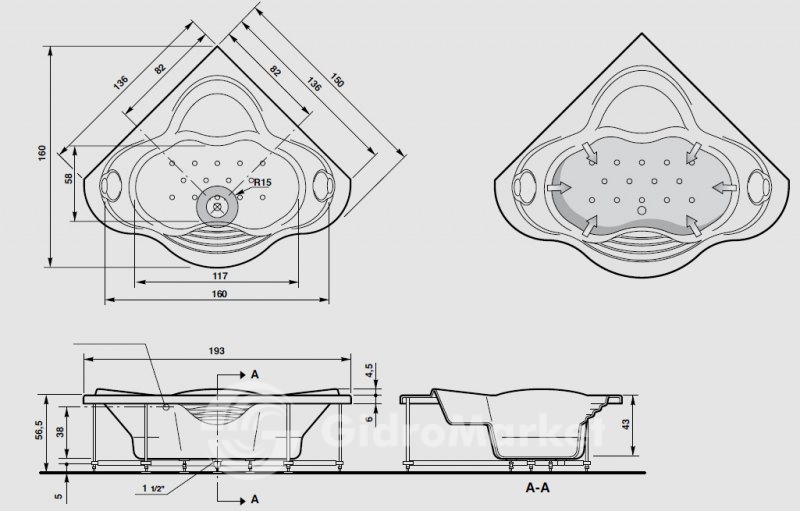
Such compact plumbing fixtures are popular not only because they save space, although this can be called its main advantage. Thanks to its ergonomic, well-thought-out shape and angular location, it is as comfortable to use as full-size models, while significantly less water is consumed. The load on the base is also small, and even for exclusive products made of stone or cast iron, reinforcement of the floors is not required. As for the external appearance and design, there are no differences between small and large baths no: all models have attractive stylish look, there are options with decorative finishing, various shapes and colors.
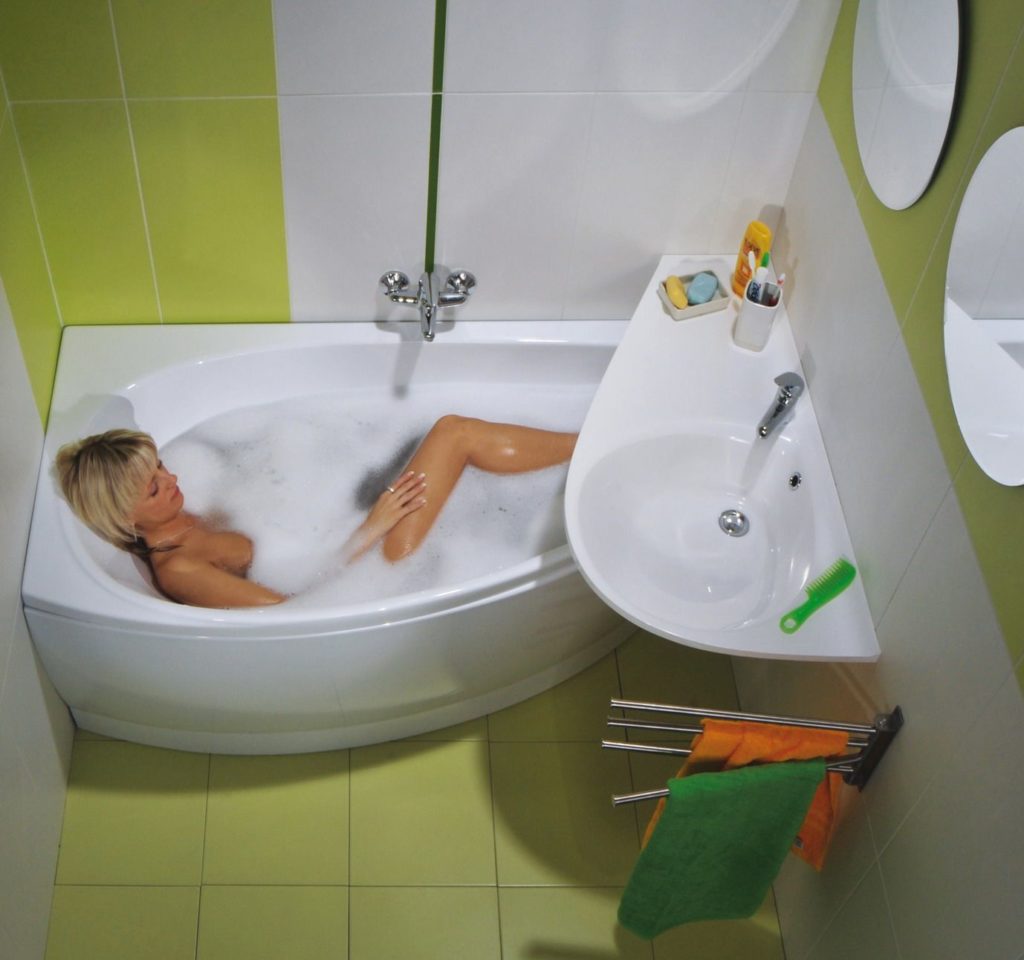

Characteristics of small baths
Corner baths small size differ in configuration, size, material of manufacture and equipment. Depending on this, the cost of the products also varies - there are compact models that cost several times more than a regular bathtub with standard parameters.
Bowl shape
Most of the range of corner baths is represented by symmetrical models in the shape of a quarter circle. This design fits perfectly into any corner, tightly adjacent to the walls, and looks very attractive. The mixer is usually located on the left or right on the side, less often on the front side. There are hexagon-shaped bowls, which are also installed in the corner; they take up little space, but inside are spacious enough for comfortable bathing.

Next come asymmetrical models, among which the most common are bowls in the shape of a trapezoid and a trimmed oval. They are divided into right- and left-handed, very compact in width, allowing you to comfortably stretch your legs during water procedures. Such designs are ideal for installing shower curtains, which makes it possible to successfully combine a shower and bath in a limited area.


Material of manufacture
Corner mini-baths made of cast iron are the least common on sale. This material is not distinguished by its plasticity and ease of processing, and therefore the range cast iron bathtubs very limited. Such products are ideal for a bathroom decorated in a retro style.
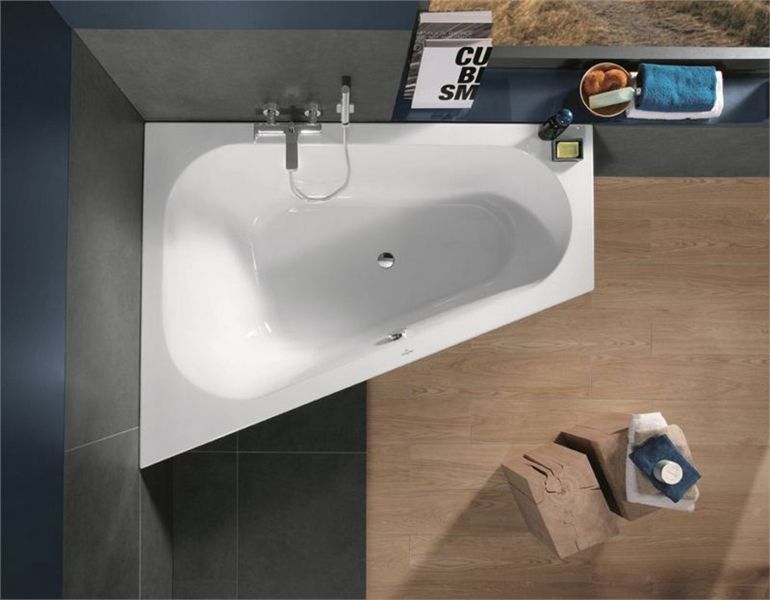
Stainless steel bowls are more widely available on the market, and choosing a small corner model is not difficult. Steel baths inexpensive, lightweight, easy to care for, but they cool down quickly and make a loud noise under running water, which many people really don’t like.

Acrylic bathtubs do not have these disadvantages, and are currently considered the most popular. The plasticity of acrylic allows you to produce bowls of absolutely any shape and size, thanks to which the choice of acrylic bathtubs, including corner ones, is incredibly wide. They are made from cast and extruded acrylic, and finished goods have different characteristics. Casting baths are considered more reliable and durable, subject to strict adherence to production technology.
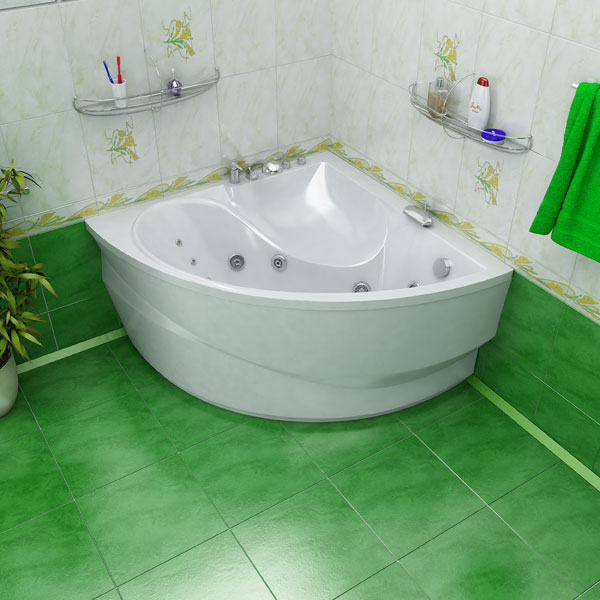
Quaril bathtubs made from a mixture of acrylic and quartz have excellent characteristics. They are more durable, very wear-resistant, and have an impeccable appearance. Production technology allows you to create bowls of any configuration, and therefore the choice of corner quaril models is quite extensive. But their cost is higher than that of acrylic ones, and such products cannot be called budget.

A large segment of the market is occupied by bathtubs made of artificial marble. Strong, durable, resistant to adverse effects, these bathtubs are most attractive for their appearance. They come in snow-white and imitate the natural texture of stone, and look very luxurious in the interior. There are few disadvantages to such products, and the most significant is the high price.

Equipment
Despite their compact size, small bathtubs are equipped in almost the same way as full-size ones. Depending on the model, the bowl may have the following options:
- various types of hydromassage;
- air massage;
- chromotherapy;
- disinfection system;
- overflow protection;
- contour lighting;
- electronic control panel;
- Dry start protection.

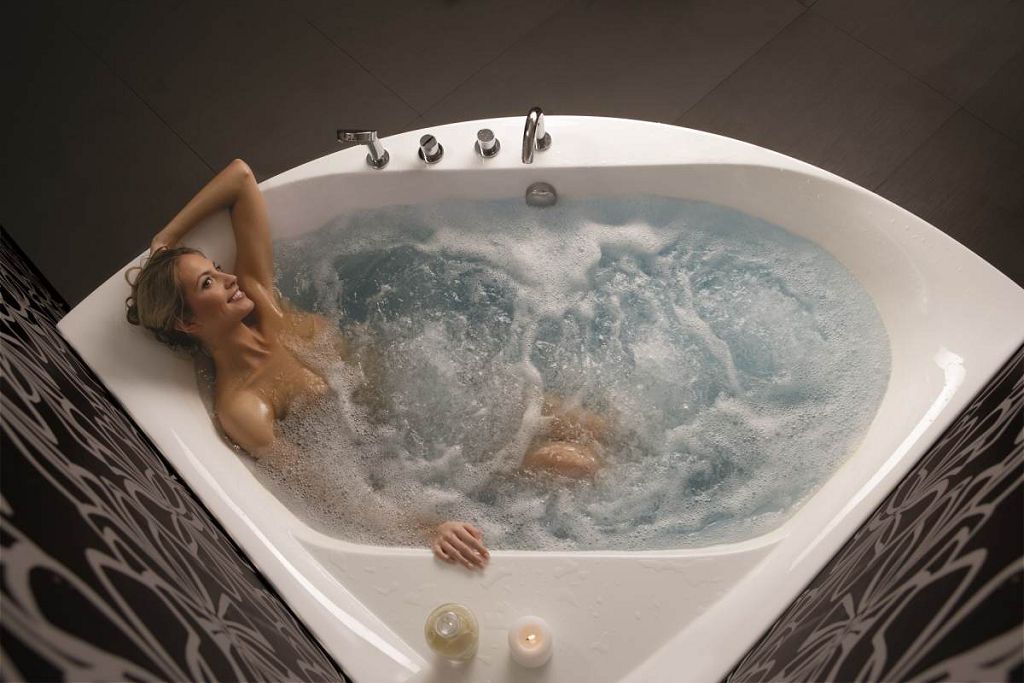
To increase bathing comfort, bathtubs can be equipped with comfortable headrests and grab bars, and deep bowls have built-in seats. Many manufacturers offer basic models, the configuration of which can be customized at the buyer’s request for an additional fee.

The best manufacturers of compact sanitary ware
In terms of quality and functionality, the best small bathtubs are considered to be Italian-made models. The leading positions are held by the brands Jacuzzi, Cezares and Albatros, whose products have already earned a lot of positive feedback from domestic consumers. Convenient, very compact, reliable bathtubs have attractive design, and even the most simple models look elegant and solid. The only disadvantage of Italian baths is their high cost.

More affordable, but with the same high quality, small bathtubs made in Czech Republic. The Riho and Ravak brands offer a wide selection of angular symmetrical and asymmetrical models made in modern style. The price range allows you to choose best option for any budget, with quality budget baths no worse than the most expensive models.
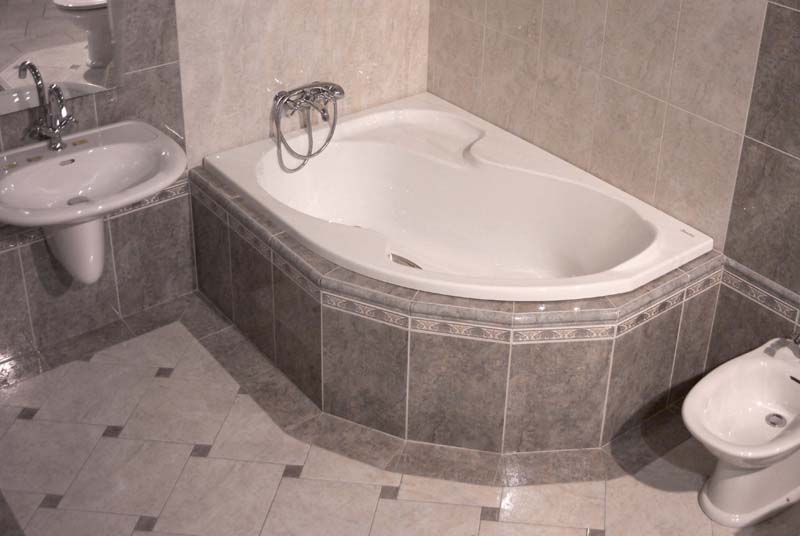

Bathtubs from the Slovenian company Kolpa-San, the Polish Сersanit, the Austrian-Polish Alpen, and the Spanish Roca are in high demand. These are mainly acrylic models made by injection molding. They are valued for their functionality and high reliability, which is confirmed by a long warranty period.

Among domestic companies there too worthy of attention manufacturers: Triton, Radomir, 1Marka, Akrilan. Corner small baths Russian production They have an ergonomic shape, a neat appearance, and an optimal ratio of quality and price. As in foreign models, the equipment is characterized by wide functionality; basic options can be equipped at the request of the buyer.
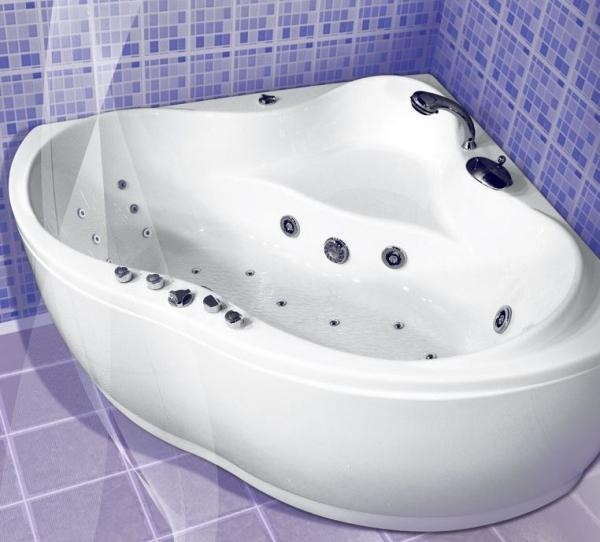
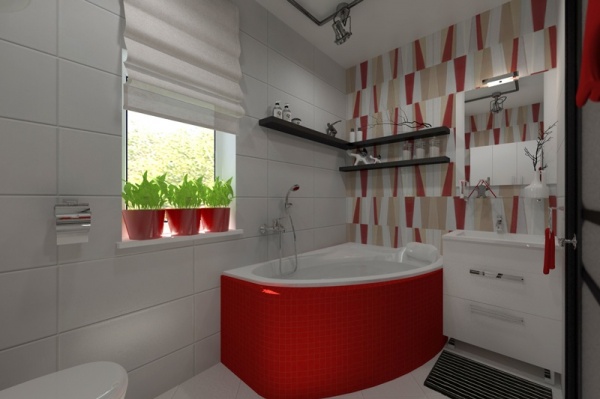
Popular models of compact baths
| Model, manufacturer | Main characteristics |
|---|---|
| Corner compact model white. The dimensions of the bowl are 130x130 cm, depth - 45 cm. The bathtub is made of acrylic, the design is made in a modern style. The package includes a frame and front panel; it can additionally be equipped with a semi-automatic drain and overflow system |
| Basic symmetrical model 130x130 cm with a capacity of 230 liters. Made in a modern style, acrylic. At the buyer's request, it can be equipped with a headrest, overflow protection, a hydromassage system with several modes, underwater lighting, a water level sensor, a disinfection system and various types mixers |
| Very compact symmetrical model. The bowl dimensions are 120x120 cm, the volume is 190 l. The set includes legs, front panel and mixer tap. The spout for filling the bowl is purchased separately, as is the drain-overflow system |
| Asymmetrical bathtub 80x140 cm. Height from the floor 62 cm, bowl volume 220 l. Although this model cannot be called very small, it is still quite compact and is perfect for small bathrooms. The package includes a screen and support frame; the drain and overflow must be purchased separately |
| Asymmetrical compact bathtub measuring 76x140 cm and height 60 cm. Made in a modern style, acrylic, bowl volume 170 liters. Bath has anti-slip coating, equipped with a frame and a drain-overflow system. Optionally, it can be equipped with hydro- and aeromassage, underwater lighting |
How to choose a small bath
The main criterion when choosing a small bath is the size of the family members. It will be difficult for a person with a large build to use such a bathtub, especially with an asymmetrical narrow bowl. If none of the people living in the apartment have a large build, choosing the optimal compact size option will not be difficult.

First of all, you need to decide where it is more convenient to place the bathtub and take measurements of the selected area. Be sure to consider the width of the aisle and the location of furnishings so that you don’t have to rearrange everything after the purchase. Take measurements as accurately as possible, leaving a margin of a few centimeters around the perimeter of the site.

It is best to draw up a bathroom plan, measuring all the distances in order to most successfully place the plumbing fixtures
It is best to choose plumbing fixtures in large stores or on the official websites of representatives of well-known brands- this way you will avoid the risk of purchasing a fake. Upon examination suitable model carefully inspect the outside and inner surface, check the package and make sure there are no visible defects. Be sure to compare the dimensions of the bathtub with your measurements. Buy a product only after presenting a quality certificate, and you must also receive a warranty card.
Installing a corner bath
The size of the bathtub does not affect the installation technology, and the only difference is the smaller physical activity, which is due to the weight of compact models. The main condition for installing a corner structure is the evenness of the walls and the corner itself. Defects in the floor can be compensated for by adjusting the legs or building a podium under the bathtub, but ensuring a tight fit of the sides in a crooked corner will not work. As a rule, leveling is carried out in advance, even at the stage of wall cladding, and the installation of plumbing does not cause problems.
Steel and acrylic models are installed in two ways - on a frame and on a brick base. The first option is much simpler to implement and requires very little time and effort for installation. The second method is more reliable, so it is used in cases where it is expected increased load on the design. To work you will need:
- construction square;
- level;
- drill with a set of drills;
- sealant;
- bath baseboard.
Step 1. The corner is freed from all unnecessary things and measurements are taken with a square. If there are noticeable irregularities, it is necessary to dismantle the tiles and re-align the walls and tiling around the perimeter of the bathtub. If the surface is flat, you need to make sure that the tiles fit tightly everywhere and that there are no cracks or voids.
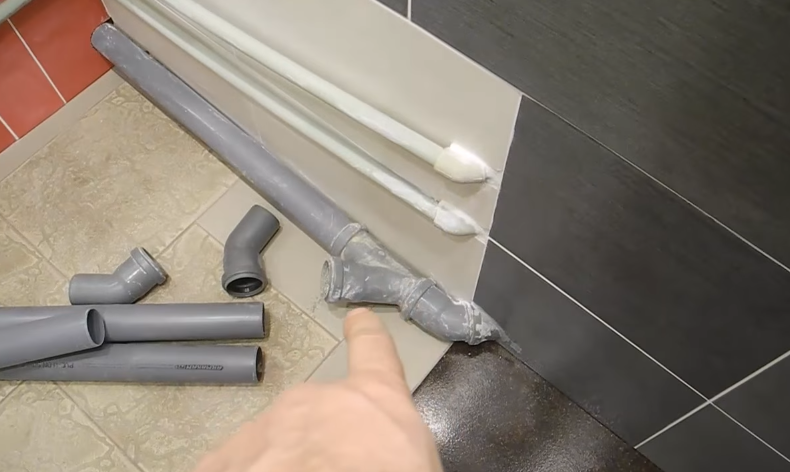
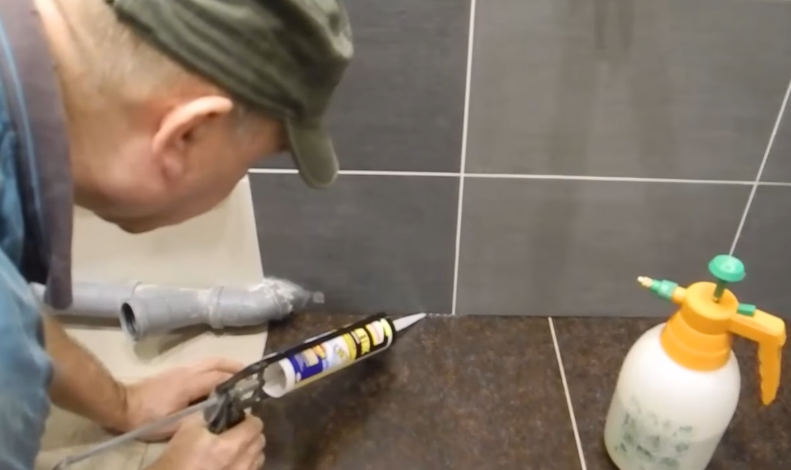
Step 2. The bathtub is unpacked and all fasteners are checked. According to the manufacturer's instructions included with the product, a support frame is screwed to the bottom of the bowl. To do this, first apply guide rails, mark points with a pencil through the mounting holes, and drill to the depth specified in the instructions. The guides are screwed in with self-tapping screws, then the legs are inserted and fixed.
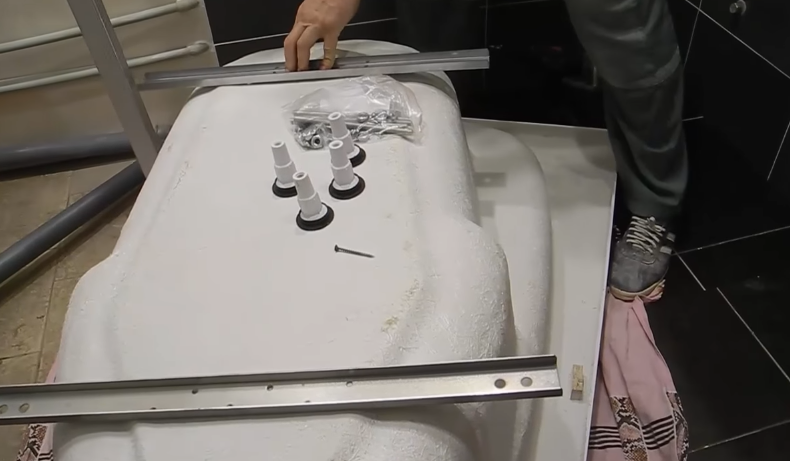
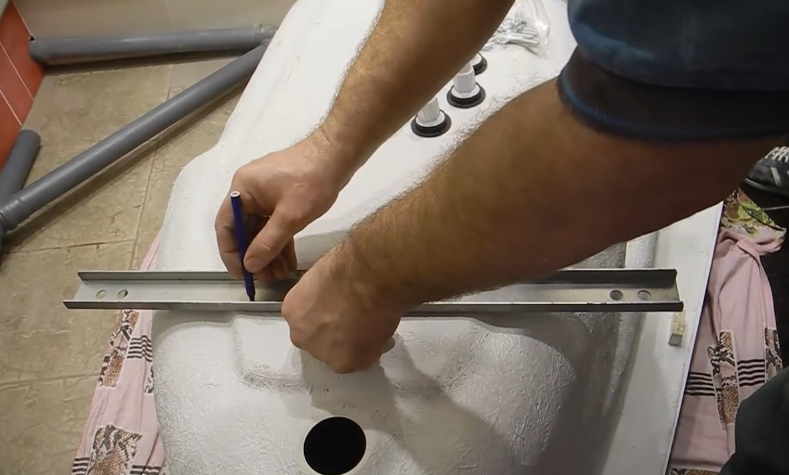
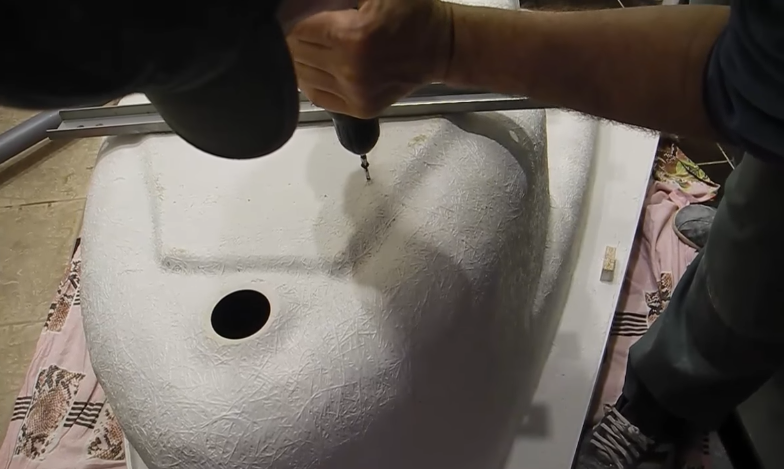

The frame should fit snugly against the body of the bowl and not move even a millimeter when pressed. But the nuts on the legs cannot be tightened all the way yet - this is done after the legs have been adjusted in height.
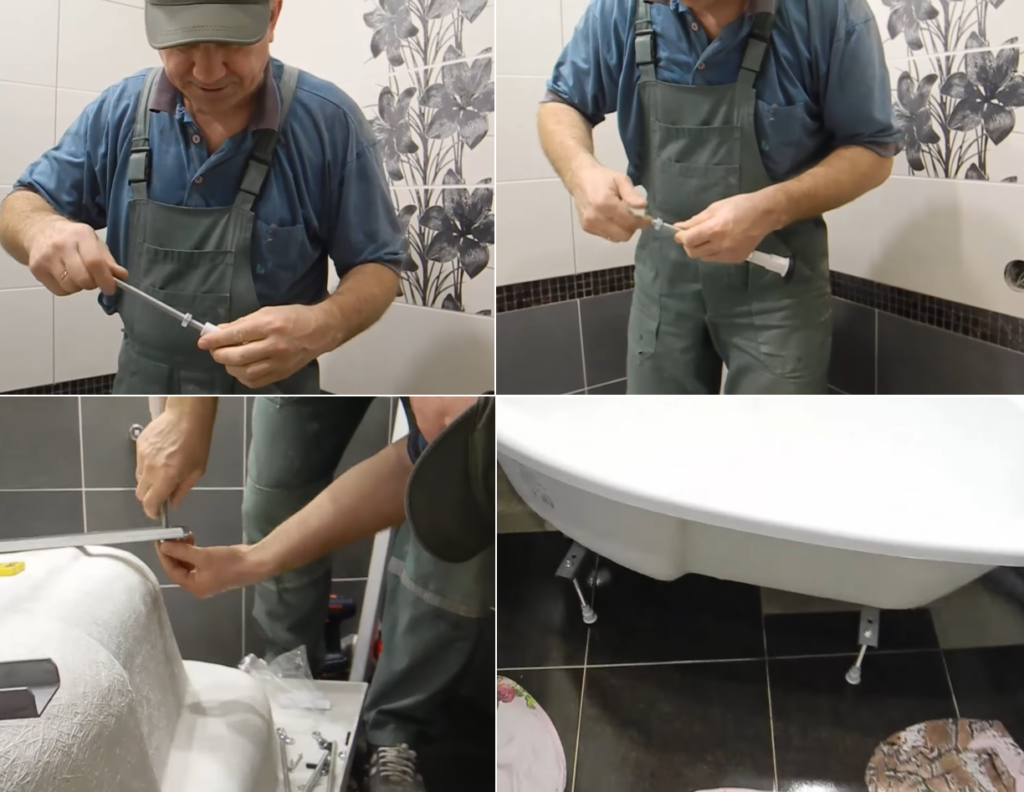
Step 3. The bathtub is turned over, carefully placed in a corner and moved close to the walls. Place a building level on top of the sides and begin to tighten the fasteners on the legs, leveling the bowl horizontally. When the height is adjusted, the nuts are tightened all the way to securely fix the legs in the desired position.

Step 4. The bathtub is moved away from the wall and a mixer, drain grate are installed, and a siphon is connected.
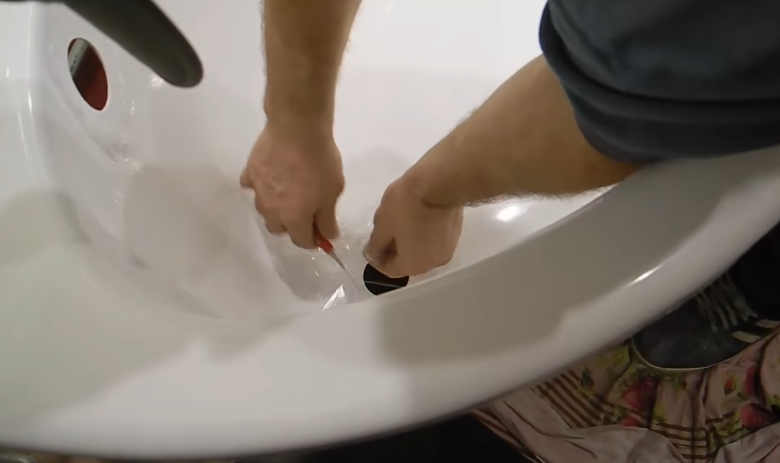
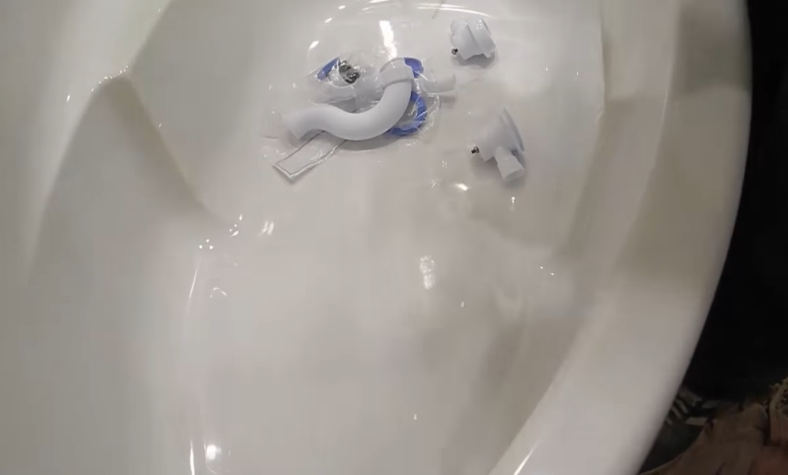
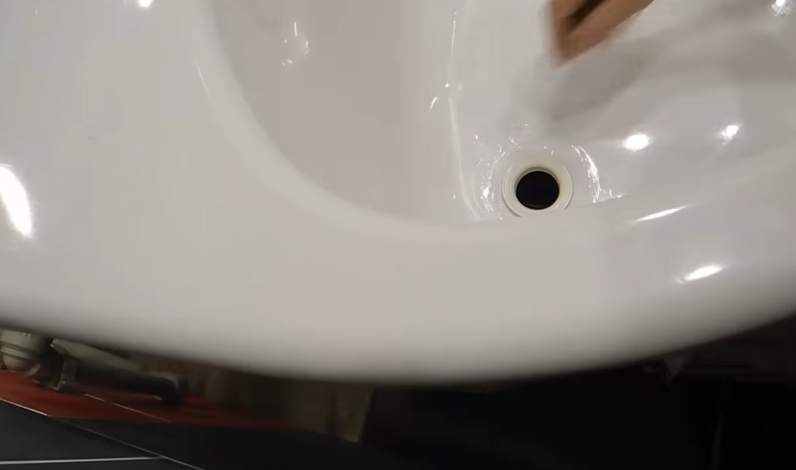
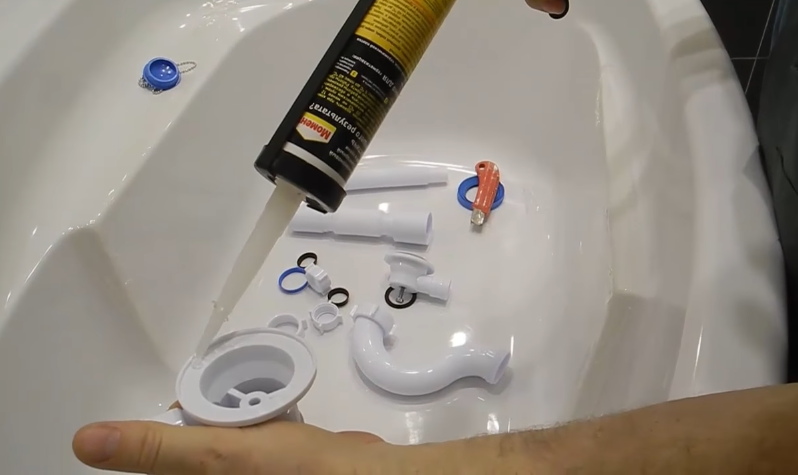
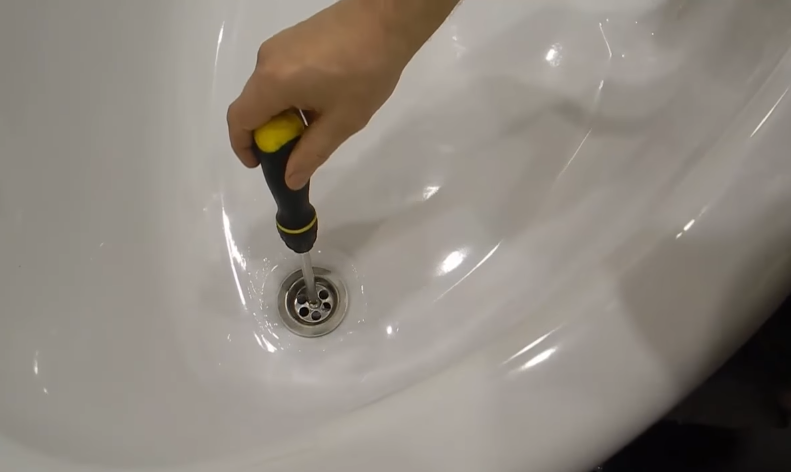
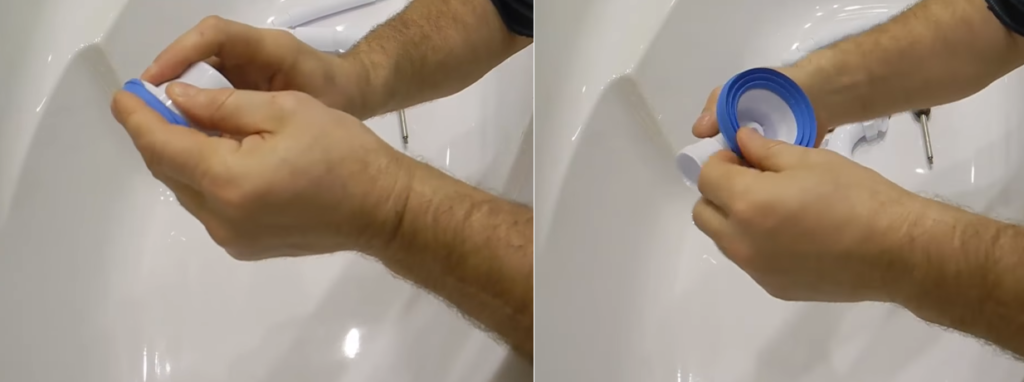
Installing a seal on the siphon part, which is attached to the upper drain hole of the bathtub
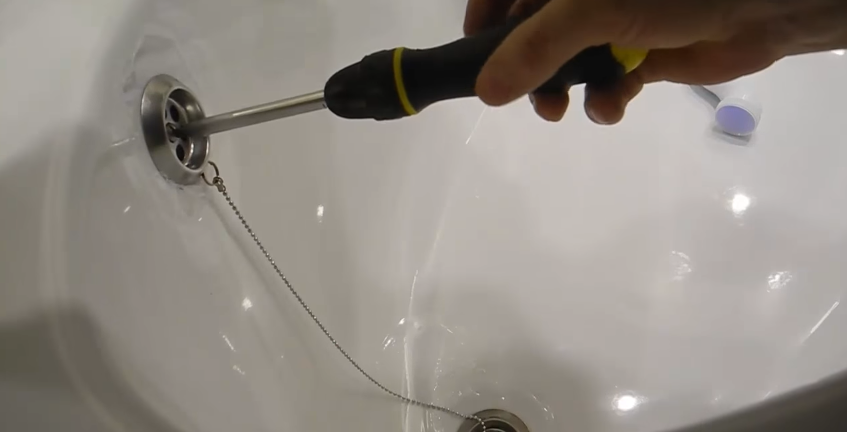
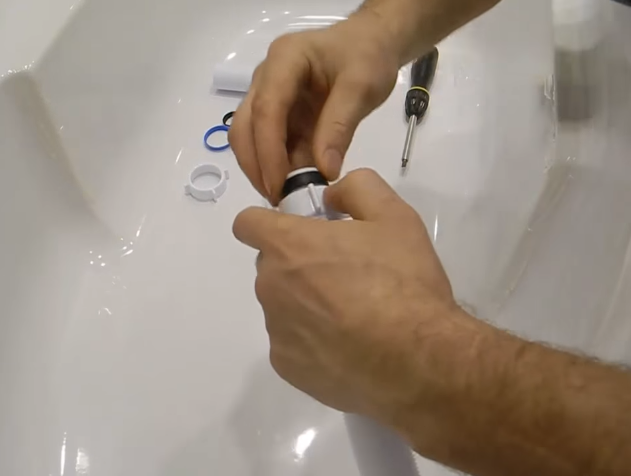
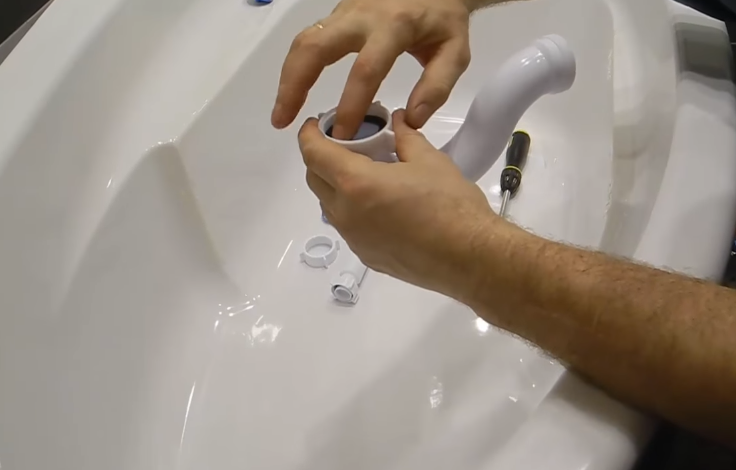


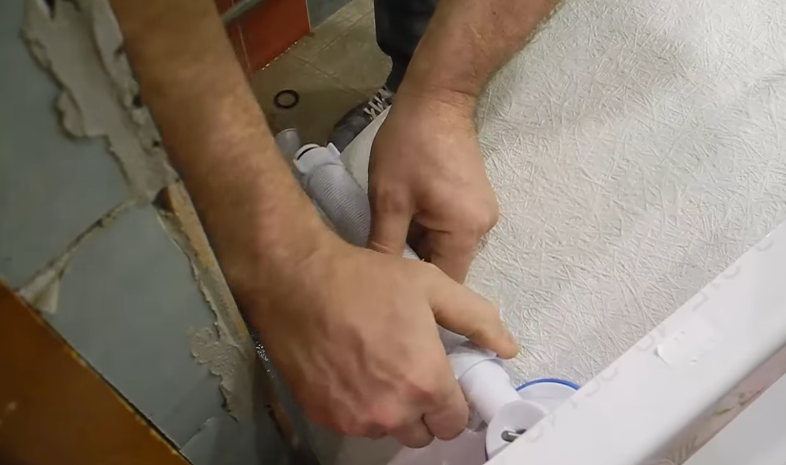
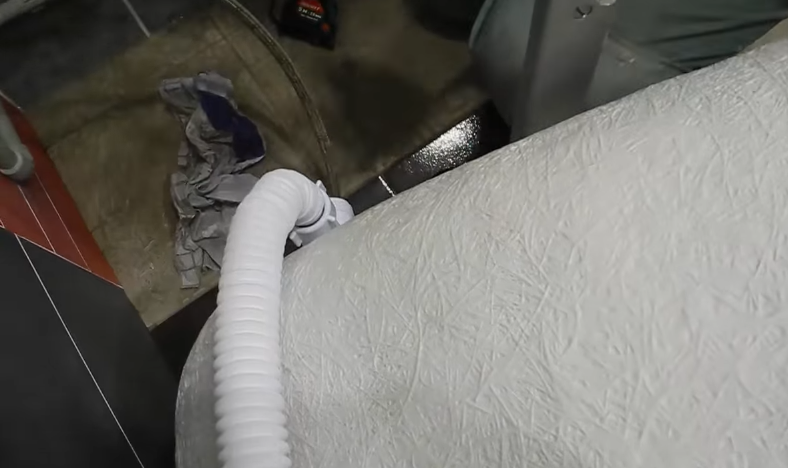
![]()
If the design provides for additional fastenings to the wall, at the same stage, mark the locations of the fasteners, drill holes in the tile for the dowels and screw the fasteners.

Step 5. If the kit includes handrails, they are applied to the side of the bathtub, aligned and carefully outlined with a pencil. Next, apply a template to the markings and use it to mark drilling points for fasteners. Very carefully drill the holes, clean them and insert the mounting screws, after applying a waterproof sealant to the washers. Screw in the screws from the bottom side of the side, tighten the nuts until they stop so that the handrail cannot move under load.
Step 6. The bathtub is placed tightly in a corner, the horizontal position is checked again with a level, and the water supply and drain are connected. Turn on the water and check for leaks at the connections. If leaks are detected, tighten the nuts more tightly and check again.
Step 7. Install decorative screen. Place the top edge under the side of the bathtub, level it, then mark the location of the side edges of the screen with lines on the walls. Holes are drilled along these lines and fastenings are screwed in. metal plates L-shaped. Next, apply the screen again, secure it along the top edge, screw it on the sides with self-tapping screws and close the fasteners with decorative plugs.
You can also make the screen yourself from profiles and plasterboard with a beautiful mosaic cladding.

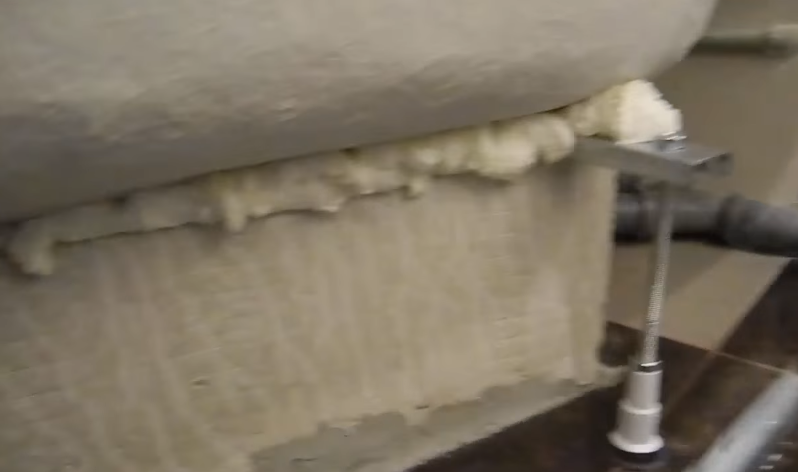
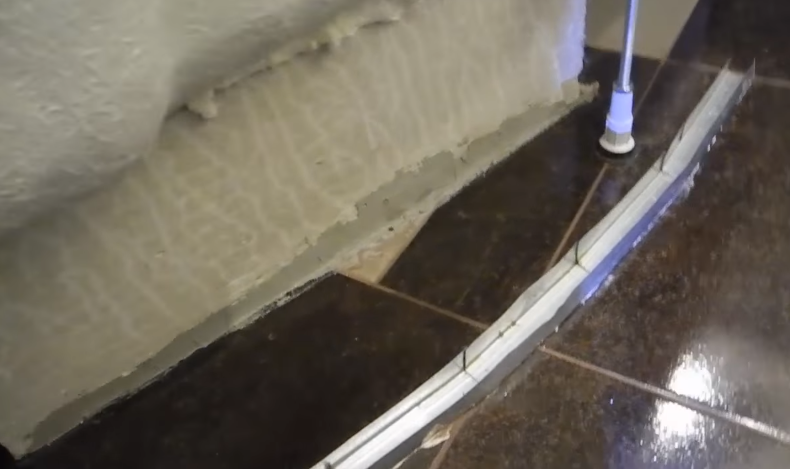



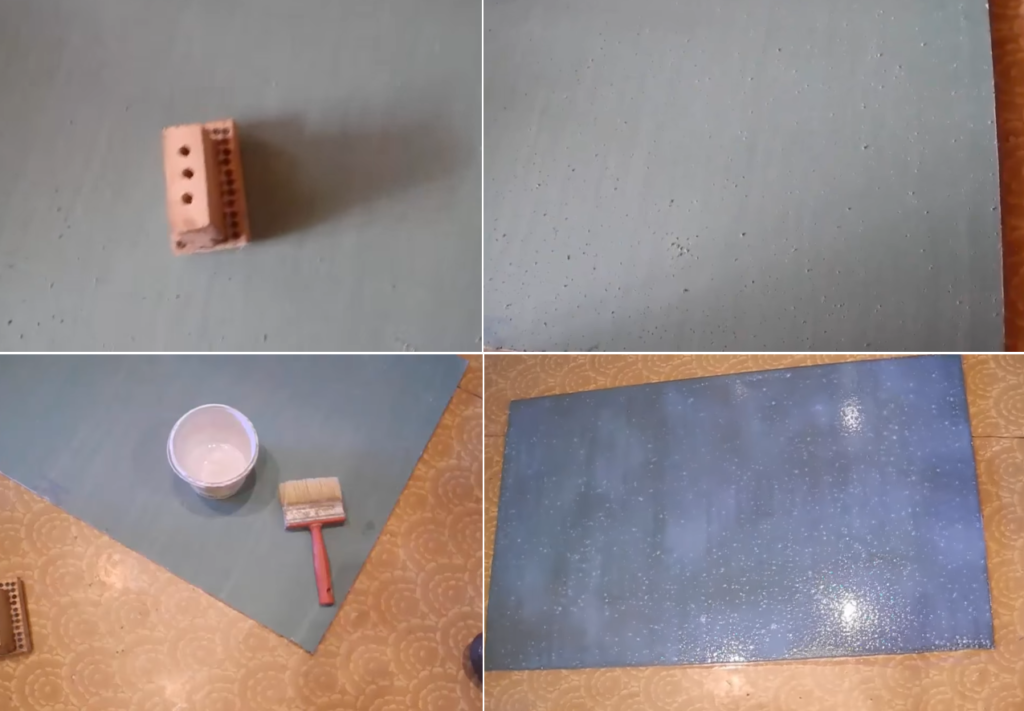
![]()
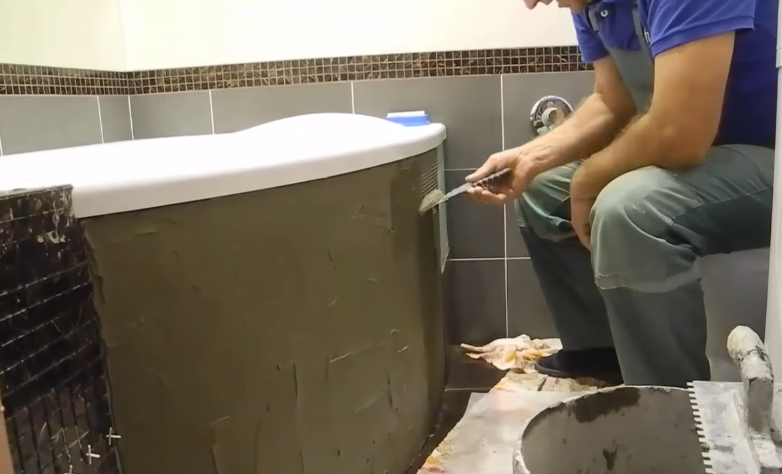
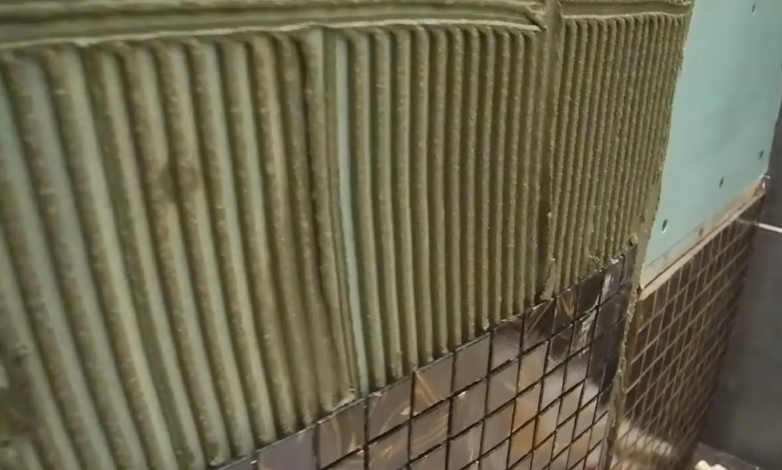
Step 8 A decorative plinth is glued along the perimeter of the bathtub, and the joints between the screen and the walls are sealed with sealant. At this point, the installation of the corner bath is considered complete.



Video - Small corner bath
Video - Installing a corner bath
Choosing plumbing fixtures on the domestic market in a few minutes recent years has been significantly expanded with new models of corner bathtubs and the materials from which they are made. Corner symmetrical and asymmetrical models attract many buyers with their beauty, practicality, comfort, and originality. With the help of such products, you can transform the bathroom space beyond recognition, give it high functionality, comfort. This article shows the dimensions of corner bathtubs, both symmetrical and asymmetrical.
Main size indicators
A person visits the bathroom several times a day. The design of its decoration should be approached as collected and concentrated as possible, paying attention to every little detail. Then the interior of this room will turn out to be truly practical, comfortable, and attractive.
Many bathroom owners are faced with the question of which bathroom to choose for a private home. An excellent option would be a corner bathtub of different sizes and shapes.
Today the corner bathroom different sizes seeks to acquire big number buyers. The design is incredibly popular due to its high convenience, practicality, durability, and visual appeal. Of course, the cost of corner models is an order of magnitude higher than regular models rectangular shape, but for more original design and a high level of comfort, there is no fear in overpaying.
With their help, you can give your bathroom a unique originality, but it is important to realize that a corner bowl takes up quite a lot of space. free space. Before purchasing it, it is important to study the market offer regarding the size of such products. This will make it possible to understand which size is most suitable for a particular room. To learn the rules for calculating the actual size of a bathroom, read this article.
Assess the scale of the free space of the bathroom visually. Think about what interior items are planned to be placed here. mandatory, and which ones can be abandoned in order to fit an acrylic corner bathtub, the dimensions of such plumbing fixtures are varied, and the bathroom needs to be measured using a construction tape.
Sizes are one of the most important characteristics this class of bowls. Knowing them, you can determine the dimensions of the sides of the bowl, that is, its length and width in cm. The most common today corner models with dimensions of 130 cm. They are equipped with hydromassage, patented bottom air nozzles, which makes them very comfortable and practical to use.
But besides angular dimensions It is important to imagine the width, length and height of the bowl. These parameters are also measured in cm. You need to know them in order to calculate the general arrangement of interior items and plumbing fixtures in the bathroom. Please note that some models of corner built-in bowls can be made in the shape of a hexagon. This fact must be taken into account when choosing the dimensions of the bowl.


![]()


Corner bath dimensions
A corner bowl can be installed in a bathroom of almost any size and shape, which will save precious space and rationally use the corner of the room. Most models have space for shampoo bottles and cream jars. But in addition to the scale of the bowl itself, when arranging a bathroom, it is important to take into account the following factors:
- The total volume of the room is the most important factor that determines the optimal size of the bowl. The more spacious the bathroom, you can choose a larger bowl for water procedures. If the bathroom is very tiny, you will need to choose only a small product;
- desire to install other plumbing fixtures, furniture, accessories. The more there are, the more restrictions there are on purchasing a spacious bowl;
- the ability to move around the room without any obstacles. The larger the bowl, the less space stays in the bathroom. Therefore, purchasing huge models for a small bathroom is simply irrational;
- layout diagram of engineering communication systems. Bathtubs that are often too large and deep make access to communication systems difficult. And in the event of a leak or other problems, getting to the pipeline becomes extremely difficult. To prevent this, the scale and depth of the bowl must be selected wisely.

When choosing corner baths, it is important to remember that they are all divided into symmetrical and asymmetrical, which determines the size of the bowl. That is, the model can have side walls that are exactly the same or different in length.
It is also worth understanding that the structure can be oriented to the right or left, which is extremely important to consider when installing the product. Before making a choice, take a close look at the room in your bathroom and determine which bowl with a corner angle will look as organic as possible here.
Symmetrical
Symmetrical bathtubs are very easy to fit into the interior of a spacious bathroom. These are universal models of the correct symmetrical shape for lovers classic interiors. Such bowls can have the following parameters (width*height) in cm: 156x156, 150x150, 148x148, 140x140, 135x135, 130x130, 125x125. That is, you can choose a similar bowl for almost any size bathroom. So for small bathrooms in Khrushchev-era buildings, options 125x125 or 130x130 are suitable, and for a spacious bathroom in a private country house you can select the maximum size models of corner bathtubs of a symmetrical shape 156x156.
 Symmetrical
Symmetrical Symmetrical models may differ in size and from different manufacturers.
| Brand name | Dimensions |
| Ravak | 130x130, 140x140, 150x150 |
| Teiko | 120x120, 135x135, 140x140, 147x147, 148x148, 156x156 |
| Kolo | 125x125, 130x130, 135x135, 140x140, 145x145, 150x150 |
I think large sizes symmetrical models, they look very presentable and are able to provide a person with maximum comfort. But at the same time, this quality is an obstacle to installing such a bowl in a small room.
Note that it is important to take into account the material from which the symmetrical model for the bathroom is made. After all, such plumbing can last up to 15 years, which means you need to choose it carefully, paying attention to every little detail. If this is a steel option, then it will have a more or less affordable price. For this reason, such designs are relevant in small-sized bathrooms, which means the bowl itself should not be too large in size. If you want to choose a cast-iron model at a high cost, then it is better to install it in spacious bathrooms. In a small bathroom, installing such a bowl will simply be very problematic. A universal option is acrylic products. It is affordable and comes in a wide variety of sizes and shapes.
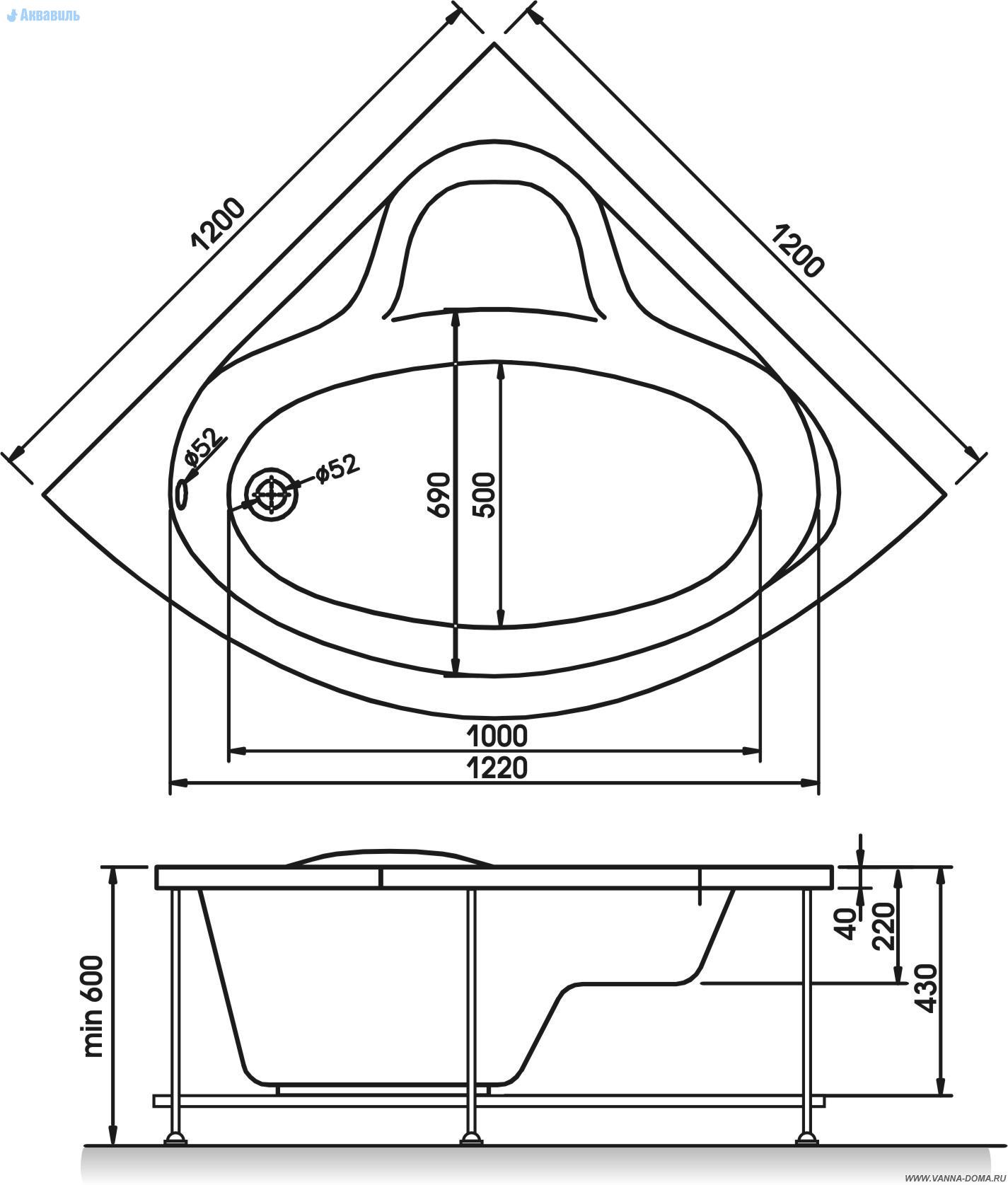



Asymmetrical
Such plumbing fixtures are a relatively recent development of modern industry and are made from sheet acrylic. It is thanks to this material with high performance parameters (flexibility, strength, wear resistance) that modern bowls can take on an asymmetrical shape.

Asymmetrical bowls with a corner configuration look very dignified. They are comfortable and allow you to take water procedures with the maximum level of relaxation and recuperation. Many buyers want to choose such a bowl for their home, but you can get lost in the variety of sizes.
Today you can buy such a bathroom of different dimensions: 185x105, 180x130, 175x105, 175x100, 170x105, 170x100, 160x125, 160x100, 160x80, 160x75, 150x105, 150x100, 75, 140x105, 100x90.
Due to the wide variation in sizes of such models, there are practically no bathrooms for which it would be impossible to choose an asymmetrical bowl. This allows designers to create with their own hands original interiors with a unique beauty and originality.
| Brand name | Dimensions, cm |
| Ravak | 170x105, 140x105, 185x105, 150x100, 160x105, 150x105, 170x110, 150x75, 160x75 |
| Teiko | 180x130, 160x130, 160x90, 150x100, 160x105, 150x105, 175x110, 170x100, 160x75 |
| Kolo | 170x105, 160x100, 150x100, 160x80, 140x100 |
Height
A successful layout of the bathroom space largely determines the level of its comfort, practicality, and beauty. Therefore, to questions of selection optimal sizes cups must be approached consciously.
The generally accepted standard norm for the height of the bathtub from the floor is 60 cm. This level is optimal so that a person of average height can step over the side of the bowl without additional difficulties. It is 60 cm that is suitable for both children and the elderly. Although deviations up or down are also quite acceptable. It all depends on what preferences the home owner has, because the lower the height of the bathroom, the more original it looks. And the higher its sides, the more comfortable it is to take water procedures.

If you make a mistake with the choice of this parameter, the design of the room will no longer look advantageous. In addition, swimming in a bowl with an irrationally chosen height can be uncomfortable. Excessively high sides are difficult to step over, and excessively low sides will not allow a person to have free access to communications under the bowl.
Therefore, if you want to emphasize the height of the bowl for the sake of beauty, simply install it on a pedestal. This will diversify the usual interior of the bathroom and draw attention to this central design detail. Professional designers also suggest using other original ideas to highlight the water treatment area against the background of other pieces of furniture, plumbing elements and wall decoration. This will allow you to achieve, without reducing the level of comfort of the model, aesthetic appeal
bathroom
Depth
No less important is the corner bath parameter, depth. It largely determines the level of comfort of water procedures in a bowl, and therefore influences the formation of the cost of a particular bath. For standard models
this figure is 60-80 cm. Such bathrooms are familiar to domestic consumers and are very popular in the plumbing market of our country. A similar choice is made by those buyers whose height is close to the average. It is easy for a person of average height to step over the side of a corner bathtub with a depth of 60-80 cm without additional difficulties.
On the other hand, spacious bowls, the depth of which does not exceed 40-50 cm, are also in quite high demand. Such models seem uncomfortable only to those people who have never basked in such a bowl. It is very convenient to have such a bathroom for families with small children. Because the low side of the bowl and its low depth allow children to take water procedures without danger to life and health.
And for lovers of deep baths, manufacturers produce options with a depth of 90 cm. Such a bowl often has flat sides so that it does not look bulky. This option is perfect for tall people of average build. But short people may find it uncomfortable to bathe in such a bathtub, which is important to consider when choosing a model for your home. We also note that different types of corner baths have different optimal depths. Yes, for cast iron model
this figure is higher, since the material from which it is made can withstand fairly high loads. A corner acrylic bathtub, the dimensions of which may vary, will be less resistant to loads, so manufacturers do not make such corner structures excessively deep. Upon closer examination corner baths, do not rush into a decision. Please note that the main criterion in this case is still the needs of family members. It is their preferences, as well as comfort, that will determine the operational parameters that the bowl should have.




Video

Bath is the main attribute modern bathroom. At the same time, the corner version of plumbing is one of the most common. But in order for the selected product to look organically in the room, you must take into account dimensions.
Today, plumbing manufacturers have begun to massively produce various modifications of products, each of which is designed to rationally use square meters in small and spacious rooms.
Basic indicators
First, it’s worth understanding how you can calculate the parameters of corner baths. But the first step is to evaluate the linear parameters of the space allocated for plumbing. If you want to equip your bathroom from scratch, you should think in advance about what equipment will be located and where. As a result of such an analysis, it will be much easier for you to evaluate which can fit into the room.
Please note: Dimensions are very important parameter any type of plumbing. Thanks to this, you can set the width and length of the product, determine its height and depth. The standard size of a corner bath is 130x70 cm. It is simply necessary to take these parameters into account in order to most accurately calculate the relative position of plumbing fixtures in the room.
Symmetrical and asymmetrical models

Traditional and corner ones can be installed in bathrooms of any size. Today, the sizes and types of corner baths are quite varied, the length of some models reaches 190 centimeters. Modern world plumbing offers the consumer large and small-sized corner baths of the following shapes:
- triangular;
- hexagonal;
- symmetrical and asymmetrical polyhedron;
- with a rounded or beveled corner;
- trapezoidal.
Regardless of whether the corner bath is large or small, it is manufactured in both right- and left-hand versions. The dimensions of the corner bath range from 115 to 190 cm.
Below is a table showing the most popular models of plumbing fixtures from well-known manufacturers:
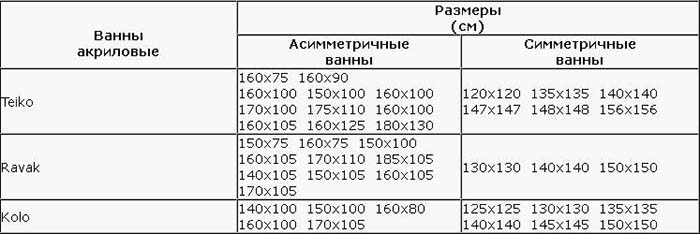
Models for two
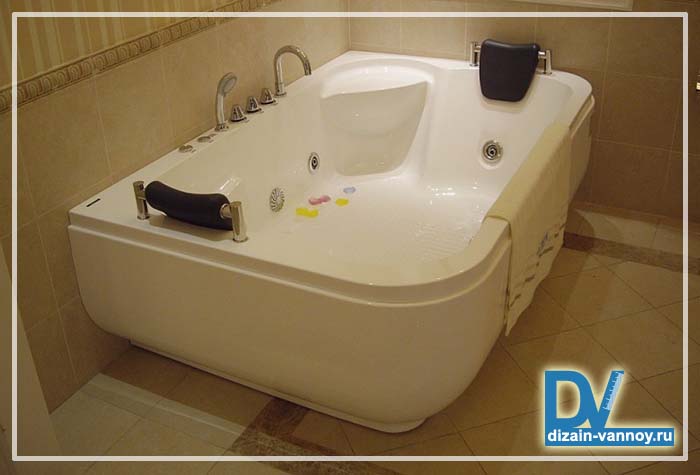
Double devices can be of various configurations:
- rectangular;
- with beveled edge;
- triangular;
- in the shape of a heart or flower;
- and other asymmetrical options.
Angle is the most advantageous and comfortable spot for installation of plumbing. Firstly, you significantly save space in the bathroom, and secondly, small corner baths, as a rule, have a comfortable fit.
Double models - great solution for married couples, newlyweds and just lovers. The photo shows those intended for two at once.
Such products can be separated by a partition, and in some versions, two bowls are connected into one large tank. But it’s immediately worth noting that corner baths are small in size , with a non-rectangular bowl, intended for sitting only. It will not be possible to assume a horizontal position in them.
But the rectangular compact corner bathtub allows you to sit horizontally in it. In such models, the drain and overflow holes are installed in the middle. This model of plumbing fixtures visually resembles an infinity sign. Small corner baths like these take up much less space than rectangular devices. The dimensions of a corner bath for two vary from 120-150 cm by 90-100.
Standard parameters

Small corner bathtubs with a triangular shape are the most popular among consumers. Traditionally, they are characterized by the following parameters:
- The length of the sides, as standard, is from 1.4 to 1.8 m;
- Product depth - 0.47-0.66 m;
- The total volume of plumbing is no more than 390-400 liters.
As a rule, the length of corner plumbing does not exceed 1.5 m. Modern market offers corner baths of various sizes. You can purchase a huge model or a compact one. It all depends on your financial capabilities and, of course, the capacity of the bathroom.
Help: Traditionally minimum size a corner bath in the shape of a triangle ranges from 0.8 × 0.8 m to 2.1 × 2.1 m. If we consider a rectangular model, its minimum length will be 0.7 m. The height of the corner bath, which can vary, should also be taken into account ranging from 0.4 to 0.8 m.
Many consumers are interested in what sizes of corner bathtubs are, but they do not take into account that the external parameters are very different from the internal volume of the product. Based on the linear characteristics, one can only judge whether the plumbing fixture will fit in a particular place in the room or not. At the same time, a small corner font with a large internal volume may be no different from a model with the same external parameters, although the capacity of the tanks will be different.
How to determine the right size?

How to choose the size of a corner bath? In fact, there is one effective method do it. The dimensions of plumbing fixtures should be assessed based on the parameters of the room where it will be installed. This takes into account the height of all family members and their build. Small corner baths are suitable for families where the height of the most tall man does not exceed 165-170 cm.
The ideal size of the plumbing fixture is considered to be one in which a person assumes a reclining position, but may not bend his legs. It is also desirable that the distance from the body to the walls of the font is at least 5 cm.
The smallest corner bathtub is unlikely to satisfy the needs of the average person. Only a child can sit comfortably in such a miniature device, so for adults the most small model bathtubs must be equipped with seats, because it is almost impossible to sit in it reclining.
What size corner baths will be optimal for a particular case depends on the parameters of the bathroom. Small room It definitely won’t be able to accommodate plumbing fixtures with dimensions of 2x2 m, but a small corner bathroom (0.8x0.8 m) will cope with this task easily.
Conclusion
Remember, before placing a corner bathtub, be sure to choose a model that will suit all members of your family. Otherwise, it will simply be inconvenient for some of them to perform water procedures in too tight plumbing.
Rectangular models have dimensions of 90-200 by 65-125 cm. If your room still does not have enough space to install such models, pay attention to short devices. As a rule, they are equipped with additional seats for more comfortable seating.
Asymmetrical models are in considerable demand, the dimensions of which vary from 130x80 cm to 170x170 cm. Their advantage is that they take up significantly less space than traditionally shaped products.
The main thing is to evaluate all the pros and cons of the model you want to purchase when choosing. Then you will definitely be satisfied with your choice and please your household, who will be able to comfortably use the new plumbing equipment.
A small bathroom in an apartment requires rational use of space. Great solution will become a corner bathtub, the size of the product helps to save usable space. As a bonus - a beautiful design element in the room.
Advantages and disadvantages
At the corner bath has its advantages:
- optimal dimensions - fits into any shower room;
- visual and useful increase in area;
- multifunctionality - many products have devices in the form of a massager and other parts;
- original design and various shapes.
Negative sides product use:
- cost - more expensive regular model;
- increase in water consumption - average capacity up to 400 liters of water;
- labor-intensive care - difficult to wash due to its size.
Corner baths are made both small and large in various shapes:

Products with rounded or beveled corners are also corner baths. Photos and descriptions of models can always be viewed in various manufacturers’ catalogs, and before purchasing, get advice from a specialist.
Available in right-hand and left-hand versions. Choice a certain model determined by the geometry of the room or based on individual preferences.
In triangular and trapezoidal models, rear dimensions vary from 140 cm to 190 cm. Asymmetric products - from 75x140 cm to 135x195 cm.
The capacity criterion includes many options: a small corner bath - volume from 150 to 170 liters, or a spacious model for 2-3 people with a volume of over 500 liters.
The surface of the façade of a symmetrical bathtub is radius in shape. Asymmetrical products - various configurations and radii, even in the shape of a rhombus with rounded corners. Height from 40 to 80 cm.
Corner baths and their advantages










Materials for manufacturing
Corner baths are made from various materials:

A steel bathtub is due to its low cost due to the cost of raw materials and manufacturing technology. The metal lends itself well to processing. Steel products are durable, their service life is up to 30 years. The disadvantages include high thermal conductivity - water cools quickly.
Cast iron bath subject to proper maintenance, it is durable. The material holds heat well. The disadvantages include heavy weight up to 120 kg, high cost and size of the corner bathtub. Limited model sizes are determined by the complex processing of cast iron.
Acrylic bathtub is an alloy of polymers and reinforcing mesh. They are light enough that you can install them yourself without resorting to outside help. The material holds temperature well. Bathtubs are produced in various shapes and sizes. But acrylic is sensitive to detergents, no abrasives or hard sponges are used.
Features of corner baths
Product manufacturers are trying to expand as much as possible functionality of corner bath:
- mixer location;
- different front panel;
- additional elements.
Mixer in different models Installed both in the corner area and on the side panel. If the plumbing fixtures are pre-installed on the wall, then it is better to purchase a bathtub with a solid sealed surface.
A typical kit includes the product and mounting feet. The front panel is rarely included - the façade can be chosen any way or for a specific product, and can be easily changed independently. The bodies of corner baths are often equipped with chrome-plated handles that protect the metal from excess moisture.
Complex shape - acrylic bathtubs. There may be seating. To reduce the risk of slipping, some models are made with a ribbed bottom. There are recesses on top for armrests. In addition to them, it is possible to purchase moisture-proof gel-like stands.
Some models of corner baths are equipped with shelves for accessories.
Additional functions
 The hydromassage function is a sought-after attribute of a corner bath. A mixture of water and air is supplied through built-in nozzles, providing a restorative and healing effect.
The hydromassage function is a sought-after attribute of a corner bath. A mixture of water and air is supplied through built-in nozzles, providing a restorative and healing effect.
The massage nozzle is concentrated to treat the legs and back area. Some models provide the ability to expose both zones to water at the same time.
The hydromassage system is controlled by a control panel built into the bathtub body. The mechanism is reliably sealed against water ingress. The corner whirlpool bath is programmed for various operating modes with options for spray intensity and frequency.
Dear models coated with antibacterial compounds and equipped with a self-cleaning coating. Its only drawback is its high sensitivity to chips and scratches.
The color range of corner baths ranges from white to various tones. The bathtub panel is produced in color, and the sanitary fittings can be chosen according to general style bathroom.
Installation process
Installation of a corner bath you can do it yourself, especially when using an acrylic product:

When purchasing a corner bathtub, it is important not to run into a fake. At the time of buying steel product necessary take into account the wall thickness - from 3.5 to 4 mm. But you won’t be able to measure the parameter yourself. Therefore, it is necessary to lift the bathtub or move it. If this is not difficult to do, then the manufacturer has saved on material. The weight of a steel corner bath is about 20 kg.
A steel product must have smooth, streamlined surfaces. The enamel is uniform and smooth.
High-quality corner bathtubs made of cast iron are distinguished by even, smooth sides. The coating is free of bumps and other defects.
Choosing acrylic products It’s better to pay attention to time-tested brands: V agnerplast, 1 Marka, Ravak, Alpen.
Long-lasting bathtubs are made from cast acrylic in Germany, England and Holland. The parameter must be in the product passport.
Products made from acrylic sheets, thickness 6-8 mm, by pressing method. The thickness of the models is reduced by 4 mm. Second layer - reinforced mesh made from environmentally friendly polyester resins. If the manufacturer claims that the wall of the corner bathtub consists of 8 mm pure acrylic, then this is a hoax.
The walls are checked for clearance - quality product does not have bandwidth. If the model is slightly translucent, then it is made of special plastic with an acrylic coating.
Low quality - strong chemical smell.
 A cast iron bath requires dryness. After each use, wipe the product dry with a soft cloth. Once a week, wash the surface with a solution of laundry soap.
A cast iron bath requires dryness. After each use, wipe the product dry with a soft cloth. Once a week, wash the surface with a solution of laundry soap.
The steel structure does not require special care. It is enough to wash it weekly with any cleaning products.
Acrylic corner bathtub is demanding:
- Liquid compositions are used to care for acrylic surfaces; the preparations do not contain abrasives.
- Soft brushes and sponges are used.
- A soft cloth soaked in furniture polish restores shine.
- Stubborn stains can be removed using household products intended for smooth surfaces.
- The bathroom is cleaned two or three times a month with special detergents.
- When bathing animals, a mat is placed on the bottom to avoid scratches.
- Metal basins and buckets are not used; items are replaced with plastic.
- Do not use chlorine-containing products, acetone or acids.
- If scratches are found on the surface, they are cleaned with fine sandpaper and treated with polish.
- After use, the acrylic corner bathtub is washed with a soap solution and wiped dry with a soft cloth.
Corner baths are made in various variations. Their sizes specifications and the photo is in the manufacturer's catalogs. Based on the information received, it is possible to carry out comparative analysis products and choose the model you like.

